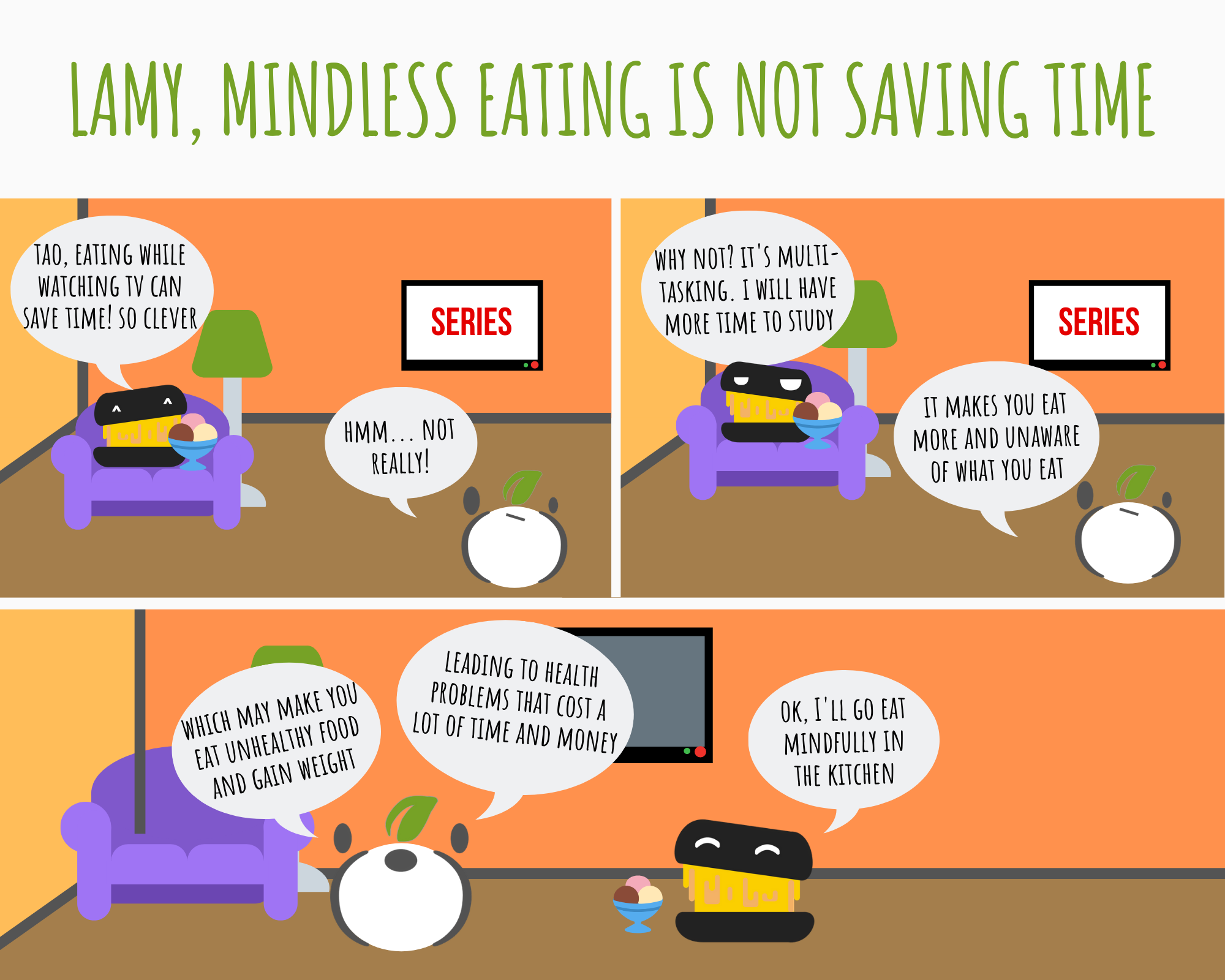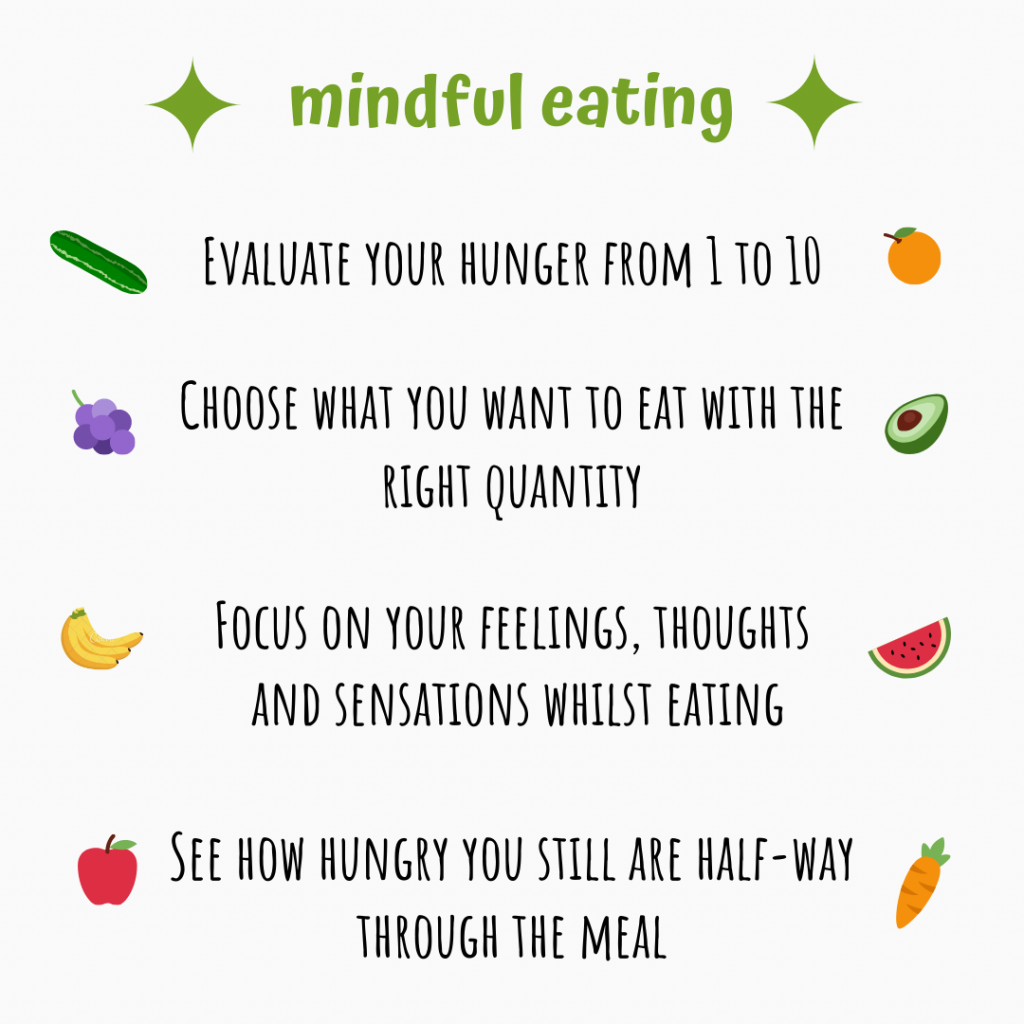Mindful Eating
… a non-judgmental awareness of physical and emotional sensations associated with eating.
Do you have the patience to wait or slow down for a moment in your life?
Can you remain unmoving till the right action arises by itself?
Can you do this while eating? Sometimes it’s difficult, isnt’it?
Mindful eating is a way to enjoy your food more and stay in control of your eating.
How, what, and why people eat the way they do, and the decisions they make (or not) to do so often lie at the heart of many bad eating habits, we can call them mindless eating habits. You are so distracted by other thoughts and feelings that eating can become random, or a response to habitual unhealthy cues, which can range from sitting down at a movie with junk food,
eating lunch alone at your computer, or simply reaching for comfort food when feeling sad.
We’ve all done it: eaten our lunch in a rush and then wondered two minutes later where it all went and how it actually tasted. When it comes to meal times, many of us could benefit from is the practice known as ‘mindful eating‘.
But what is this practice?

Mindful eating is about bringing your focus to the task you’re doing at the present moment – eating – and paying deliberate attention to what’s going on inside and around you.
Mindful eating aims to heighten your awareness. It brings the focus to your physical presence and how you are feeling internally. It is not necessarily about relaxation or happiness, although these may come as welcome side effects from eating a meal mindfully.
Mindful eating can help in identifying unhealthy behaviour patterns around food; for example, eating too much, or eating when you’re not actually hungry and don’t need to eat.
Mindful eating could be for you a way to better enjoy food and life. It puts the focus on the present moment of your meal, allowing you to slow down and take some time to savour the flavours and experience of eating. So let’s get into it!
Well, you may think that mindful eating would take you so much time, as Lamy thought. But…

Some tips to eat mindfully!
1. Start with one
Choosing to eat more mindfully doesn’t mean a complete life overhaul. Start by choosing to eat one meal per day more mindfully, eg, breakfast, lunch or dinner. If that’s too much, start with just one meal per week.
2. Check in with yourself
Before eating, stop for a moment and consider how you’re feeling. Ask yourself: am I hungry? Am I thirsty? Am I stressed, bored, worried or rushed?
Often we eat because our mind or emotions compel us to – you may reach for food for comfort or distraction. But by tuning into your body more, and eating only when you’re actually hungry or at set mealtimes, you’ll become better at knowing your real hunger cues from emotional ones. Ask yourself, “How am I feeling?” Then follow up with, “If I am feeling this way and I eat this food, how will it help me feel better? How will I feel after it?”
3. Turn off to turn up your senses
Set the scene for a mindful meal by removing screens and other distractions from the room or table. Switch your phone to flight mode, or turn off your TV. Focus on enjoying your meal as well as your own company, or that of those around you. Communicate and nurture yourself instead of being wandering with your mind.
4. Out of sight, out of mind
Keep serving bowls and leftovers off the table and out of sight while you’re eating. This can reduce the chance of you going back for unnecessary seconds and keeps the focus on your plate in front of you.
If you have trouble controlling portion sizes, try eating off a smaller plate. This can help to reduce your serving amounts, and stop you from feeling as if you’re missing out or depriving yourself.
5. Change gears
Meal times can be a chance to change the pace of your day and slow it down. Eating mindfully means chewing slowly and savouring the moment. Notice the colours, flavours and textures of your meal. Pause between each mouthful and put your utensils down on the plate. You will experience a greater sense of taste and pleasure from your food by doing this!
Aim to take about 20 minutes to eat a meal mindfully. Compare it to how long you would usually take to eat a meal.
6. Appreciate from farm to plate
Eating mindfully can also involve thinking about the journey everything on your plate took to get there – from where and how it grew, to the person who prepared it. Thoughts of gratitude and appreciation can add even more enjoyment to the experience of eating. Perhaps the most popular mindful eating exercise comes from mindfulness expert Jon Kabat Zinn.

Here’s how it works:
- Holding: First, take a raisin and hold it in the palm of your hand or between your finger and thumb.
- Seeing: Take time to really focus on it; gaze at the raisin with care and full attention—imagine that you’ve just dropped in from Mars and have never seen an object like this before in your life. Let your eyes explore every part of it, examining the highlights where the light shines, the darker hollows, the folds and ridges, and any asymmetries or unique features.
- Touching: Turn the raisin over between your fingers, exploring its texture. Maybe do this with your eyes closed if that enhances your sense of touch.
- Smelling: Hold the raisin beneath your nose. With each inhalation, take in any smell, aroma, or fragrance that may arise. As you do this, notice anything interesting that may be happening in your mouth or stomach.
- Placing: Now slowly bring the raisin up to your lips, noticing how your hand and arm know exactly how and where to position it. Gently place the raisin in your mouth; without chewing, noticing how it gets into your mouth in the first place. Spend a few moments focusing on the sensations of having it in your mouth, exploring it with your tongue.
- Tasting: When you are ready, prepare to chew the raisin, noticing how and where it needs to be for chewing. Then, very consciously, take one or two bites into it and notice what happens in the aftermath, experiencing any waves of taste that emanate from it as you continue chewing. Without swallowing yet, notice the bare sensations of taste and texture in your mouth and how these may change over time, moment by moment. Also, pay attention to any changes in the object itself.
- Swallowing: When you feel ready to swallow the raisin, see if you can first detect the intention to swallow as it comes up, so that even this is experienced consciously before you actually swallow the raisin.
- Following: Finally, see if you can feel what is left of the raisin moving down into your stomach, and sense how your body as a whole is feeling after you have completed this exercise.
When you become a “champion of mindful eating”, you can also stick for a drink in the same way and you will discover things about what you eat that will amaze you!